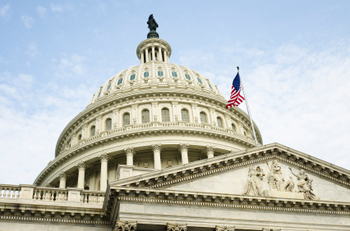
The CRA’s ban on issuing “substantially similar” rules has been misunderstood
Congress cast a very long shadow on federal regulatory agencies in March, 2001, when it exercised authority it had asserted in a 1996 law called the Congressional Review Act, or CRA for short. Invoking that law for the first and only time to date, Congress struck down a final agency rule—vetoing, after only several hours of debate, a plan to reduce ergonomic hazards in U.S. workplaces that the federal Occupational Safety and Health Administration (OSHA) had spent the previous ten years crafting.
In the eleven years since Congress exercised its veto under the CRA, OSHA has done nothing to re-start an ergonomics rulemaking, notwithstanding the continued annual toll of several hundred thousands of musculoskeletal injuries attributable to repetitive motion during work. OSHA has failed to take any further action in large part because of the prevailing belief that the CRA prohibits an agency from ever trying to promulgate a rule in the same topical area as one that Congress has vetoed.
Opponents of the ergonomics rule and of federal regulation in general, joined by the OSHA leadership in both the Bush and Obama administrations (who may find it easier to claim they aren’t permitted to wade back into this arena), have repeated this “prohibition” so often that it has become the “conventional wisdom.” But as Jason Sullivan, a former student of mine at Penn Law, and I show in a new article in Administrative Law Review, Congress in enacting the CRA actually intended to encourage agencies to fix the problems targeted by a vetoed regulation, certainly not to set up a “one strike, you’re out” tribunal.
The key sentence in the CRA that bears on the aftermath of a veto—that a vetoed rule “may not be reissued in substantially the same form”—needs to be understood not only in light of the legislative history of the statute but also of the primary purpose of the law at the time it was enacted. By narrow margins, Congress had failed to enact any of several sweeping “regulatory reform” bills in the mid-1990s that would have required agencies to demonstrate (using specific methods set out by Congress) that each final rule had benefits that exceeded (or “justified,” depending on the bill) their costs. The CRA was clearly Congress’s second-best attempt to snare individual regulations that it felt flouted the cost-benefit test—rules that presumably would never have been promulgated in the same way had one of the regulatory reform statutes passed. So the notion that “in substantially the same form” really means “to cover the same hazard(s)” is quite far-fetched. To the extent that this misreading has encouraged OSHA to shelve its ergonomics activities entirely, and may have deterred all the other agencies from issuing certain controversial regulations for fear the populace will be worse off with no protections in a whole topical area than without the specific protections afforded by the risky attempt to regulate, the nation has for more than a decade been watching opportunities to increase net benefits pass us by.
There are, in addition, many other gradations of interpretation for “substantially the same form” that are less sweeping than the common misinterpretation but still, in our view, more restrictive than the statute and basic good government principles dictate. In our article, Jason and I provide a detailed discussion of seven such interpretations, viewed through the lens of cost-benefit analysis. We conclude that, when viewed in context, “substantially the same form” means essentially “with substantially the same unfavorable cost-benefit balance.” A re-issued rule must be allowed to proceed to final promulgation if the agency responds to concerns Congress may have articulated during the veto process (although the CRA allows Congress to veto a rule without any explanation, and expressly forecloses the possibility of codifying any rationale or guidance in the veto resolution itself), and if it significantly lowers regulatory costs or increases benefits (or both). Afterwards, Congress could veto the rule again on new substantive grounds, but not on the easy excuse that the agency had no right to try again.
When it comes to ergonomics, an OSHA rule with greater benefits or lower costs (or both) will have to look rather different from the 2001 rule. I was the OSHA official in charge of developing an earlier incarnation of the failed ergonomics rule. As detailed in the Administrative Law Review, I have my own ideas (some of which were rejected at the time, I must admit) for how OSHA should restart its ergonomics rulemaking to correct those flaws that Congress couldn’t help noticing in 2001. It is possible for OSHA to innovate in ways that will increase the cost-benefit balance in ergonomics regulation far beyond what is required to pass the “substantially similar” hurdle.
But the fact is that many other kinds of regulations that hinge on a single quantitative level of stringency (such as a National Ambient Air Quality Standard from EPA) could have vastly different cost-benefit profiles just by changing a single word out of thousands—the concentration or emissions level that must be attained. So judging “the same form” can’t be an exercise in comparing versions on a word processor—it has to recognize that an agency can sometimes comport completely with Congressional expectations for change simply by altering a few key words in a regulation.
As a strong supporter of cost-benefit analysis, I welcome Congressional scrutiny of this aspect of agency regulations, but I also find it highly disappointing that many have interpreted the legislative review authority in the CRA to preclude cost-beneficial revisions of controversial rules. The CRA could be greatly improved, especially if Congress afforded the agencies an opportunity to correct misimpressions of their rules before a veto comes to a vote. But whether under the current CRA or an improved version, better still would be for OSHA and the other agencies to treat the one historical veto (and the unknown number of potential future vetoes) for what it is: a chance to do better, not a rebuke without recourse.
With Jason W. Sullivan, Adam M. Finkel is the author of A Cost-Benefit Interpretation of the “Substantially Similar” Hurdle in the Congressional Review Act: Can OSHA Ever Utter the E-Word (Ergonomics) Again?, 63 Administrative Law Review 707-784 (2011).




